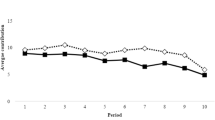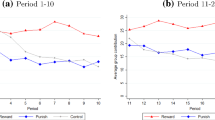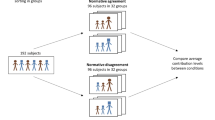Abstract
Objective: To use meta-analysis techniques to assess the impact of various factors on the extent of cooperation in standard linear public goods experiments using the voluntary contributions mechanism.
Data Sources: Potentially relevant experiments were identified through searches of EconLit, the Internet Documents in Economics Access Service (IDEAS), and a survey article.
Review Methods: A total of 349 potentially relevant studies were identified. Of these, 27 (representing a total of 711 groups of participants) met the inclusion criteria. Data were abstracted from these studies using a standardized protocol. Results were analyzed using weighted ordinary least squares. Average group efficiency was the dependent variable.
Results: The marginal per capita return, communication, constant group composition over the session (“partners”), positive framing, and the use of children as subjects had a positive and significant effect (p < 0.05) on the average level of contribution to the public good. Heterogeneous endowments to subjects, experienced participants, and soliciting subjects' beliefs regarding other participants' behaviour prior to the start of the session/period had a negative and significant effect. A number of other factors were not identified as significant.
Conclusion: The meta-analysis results parallel several key findings from previous literature reviews. In addition, they offer parameter estimates and an analysis of significance based on the totality of the available research evidence. More consistent reporting of the results of experiments would greatly improve the ability to conduct this type of research.
Similar content being viewed by others
References
American Economics Association. (September 26, 1999). http://www.econlit.org/econlit/ellistjn.html.
Baaijens, S.R., Nijkamp, P., and van Montfort, K. (1998). “Explanatory Meta-Analysis for Comparison and Transfer of Regional Tourist Income Multipliers.” Regional Studies. 32(9), 839–849.
Clarke, M. and Oxman, A.D. (eds.). (1999). Cochrane Reviewers' Handbook 4.1.5 [Updated April 2002]. In The Cochrane Library, Issue 2, 2002. Oxford: Update Software.
Croson, R.T.A. and Marks, M.B. (2000). “Step Returns in Threshold Public Goods: A Meta-and Experimental Analysis.” Experimental Economics. 2, 239–259.
De Solla Price, D. (1981). “The Development and Structure of the Biomedical Literature.” In K. Warren (ed.), Coping with the Biomedical Literature. New York: Praeger Publishers. Cited in E.R. Siegel et. al. (1990). “Bibliographic-Retrieval Systems.” In E.H. Shortliffe, et. al. (eds.), Medical Informatics: Computer Applications in Health Care. Reading, Massachusetts: Addison-Wesley.
Espey, M. (1998). “Gasoline Demand Revisited: An International Meta-Analysis of Elasticities.” Energy Economics. 20(3), 273–295.
Glass, G.V., McGaw, B., and Smith, M.L. (1981). Meta-Analysis in Social Research. Beverly Hills: Sage Publications.
Hunter, J.E. et al. (1982). Meta Analysis: Cumulating Research Findings Across Studies. Studying Organizations: Innovations in Methodology Number 4. Beverly Hills: Sage Publications.
Ledyard, J.O. (1995). “Public Goods: A Survey of Experimental Research.” In J. Kagel and A. Roth (eds.), The Handbook of Experimental Economics. Princeton: Princeton University Press.
Moher, D. et al. For the QUORUM Group. (1999). “Improving the Quality of Reports of Meta-Analyses of Randomised Controlled Trials: The QUORUM Statement.” The Lancet. 354(9193), 1896–1900.
Palfrey, T. and Porter, R. (1991). “Guidelines for Submission of Manuscripts on Experimental Economics.” Econometrica. 59(4), 1197–1198.
Pigou, A.C. (1932). The Economics of Welfare. 4th edn. London: Macmillan.
Plath, I. (1992). Understanding Meta-Analysis: A Consumer's Guide to Aims, Problems, Evaluation, and Developments. Baden-Baden: Nomos Verlagsgellschaft.
Rosenthal, R. (1991). “Meta-Analysis: A Review.” Psychosomatic Medicine. 53(3), 247–271.
Stanley, T.D. (1998). “New Wine in Old Bottles: A Meta-Analysis of Ricardian Equivalence.” Southern Economic Journal. 64(3), 713–727.
Van den Bergh, J.C.J.M., Button, K.J., Nijkamp, P., and Pepping, GC. (1997). Meta-Analysis in Environmental Economics. Dordrecht, The Netherlands: Kluwer Academic Publishers.
Wolf, F.M. (1986). Meta-Analysis: Quantitative Methods for Research Synthesis. Beverly Hills: SAGE Publications.
Appendix A: References for studies included in the meta-analysis
Andreoni, J. (1988). “Why Free Ride? Strategies and Learning in Public Goods Experiments.” Journal of Public Economics. 37(3), 291–304.
Andreoni, J. (1995a). “Cooperation in Public Goods Experiments: Kindness or Confusion?” American Economic Review. 85(4), 891–904.
Andreoni, J. (1995b). “Warm-Glow versus Cold-Pickle: The Effects of Positive and Negative Framing on Cooperation in Experiments.” Quarterly Journal of Economics. 110(1), 1–21.
Asch, P., Gigliotti, G., and Polito, J.A. (1993). “Free Riding with Discrete and Continuous Public Goods: Some Experimental Evidence.” Public Choice. 77(2), 293–305.
Cason, T.N. and Khan, F.I. (1999). “A Laboratory Study of Voluntary Public Goods Provision with Imperfect Monitoring and Communication.” Journal of Development Economics. 58(2), 533–552.
Croson, R.T.A. (1996). “Partners and Strangers Revisited.” Economics Letters. 53(1), 25–32.
Croson, R.T.A. (2000). “Thinking Like a Game Theorist: Factors Affecting the Frequency of Equilibrium Play.” Journal of Economic Behavior and Organization. 41(3), 299–314.
Dorsey, R.E. (1992). “The Voluntary Contributions Mechanism with Real Time Revisions.” Public Choice. 73(3), 261–282.
Falkinger, J., Fehr, E., Gächter, S., and Winter-Ebmer, R. (1999). “A Simple Mechanism for the Efficient Provision of Public Goods-Experimental Evidence.” Working Paper No. 3. Zurich: Institute for Empirical Research in Economics, University of Zurich. Subsequently published as Falkinger, J., Fehr, E., Gächter, S., and Winter-Ebmer, R. (2000). “A Simple Mechanism for the Efficient Provision of Public Goods: Experimental Evidence.” American Economic Review. 90(1), 247–264.
Fehr, E. and Gächter, S. (1999). Cooperation and Punishment in Public Goods Experiments. Paper available through Internet Documents in Economics Access Service. Subsequently published as Fehr, E. and Gächter, S. (2000). “Cooperation and Punishment in Public Goods Experiments.” American Economic Review. 90(4), 980–994.
Fisher, J. et al. (1995). “Heterogeneous Demand for Public Goods: Behavior in the Voluntary Contributions Mechanism.” Public Choice. 85(3/4), 249–266.
Gächter, S., Fehr, E., and Kment, C. (1996). “Does Social Exchange Increase Voluntary Cooperation?” Kyklos. 49(4), 541–554.
Goeree, H., Holt, C.A., and Laury, S.K. (1999). Altruism and Noisy Behavior in One-Shot Public Goods Experiments. Paper available through Internet Documents in Economics Access Service. Subsequently published as Goeree, H., Holt, C.A., and Laury, S.K. (2002). “Private Costs and Public Benefits: Unraveling the Effects of Altruism and Noisy Behavior.” Journal of Public Economics. 83(2), 257–278.
Harbaugh, W.T. and Krause, K. (2000). “Children's Altruism in Public Good and Dictator Experiments.” Economic Inquiry. 38(1), 95–109.
Isaac, R.M. and Walker, J.M. (1988a). “Communication and Free-Riding Behavior: The Voluntary Contribution Mechanism.” Economic Inquiry. 26(4), 585–608.
Isaac, R.M. and Walker, J.M. (1988b). “Group Size Effects in Public Goods Provision: The Voluntary Contribution Mechanism.” Quarterly Journal of Economics. 103(1), 179–199.
Isaac, R.M. and Walker, J.M. (1998). “Nash as an Organizing Principle in the Voluntary Provision of Public Goods: Experimental Evidence.” Experimental Economics. 87(5), 829–846.
Isaac, R.M., Walker, J.M., and Thomas, S.H. (1984). “Divergent Evidence on Free Riding: An Experimental Examination of Possible Explanations.” Public Choice. 43, 113–149.
Isaac, R.M., Walker, J.M., and Williams, A.W. (1994). “Group Size and the Voluntary Provision of Public Goods: Experimental Evidence Utilizing Large Groups.” Journal of Public Economics. 54(1), 1–36.
Keser, C. and van Winden, F. (1996). Partners Contribute More to Public Goods than Strangers: Conditional Cooperation. Paper available through Internet Documents in Economics Access Service. Subsequently published as Keser, C. and van Winden, F. (2000). “Conditional Cooperation and Voluntary Contributions to Public Goods.” Scandinavian Journal of Economics. 102(1), 23–39.
Laury, S.K., Walker, J.M., and Williams, A.W. (1995). “Anonymity and the Voluntary Provision of Public Goods.” Journal of Economic Behavior and Organization. 27(3), 365–380.
McCorkle, S. and Watts, M. (1996). “Free Riding Indexes for Ukrainian Economics Teachers.” Journal of Economic Education. 27(3), 233–237.
Nowell, C. and Tinkler, S. (1994). “The Influence of Gender on the Provision of a Public Good.” Journal of Economic Behavior and Organization. 25(1), 25–36.
Ockenfels, A. and Weimann, J. (1999). “Types and Patterns: An Experimental East-West German Comparison of Cooperation and Solidarity.” Journal of Public Economics. 71(2), 275–287.
Saijo, T. and Nakamura, H. (1995). “The ‘spite’ Dilemma in Voluntary Contribution Mechanism Experiments.” Journal of Conflict Resolution. 39(3), 535–560.
Weimann, J. (1994). “Individual Behavior in a Free-Riding Experiment.” Journal of Public Economics. 54(1), 1–36.
Wilson, R.K. and Sell, J. (1997). “‘Liar, Liar...’:Cheap Talk and Reputation in Related Public Goods Settings.” Journal of Conflict Resolution. 41(5), 695–717
Author information
Authors and Affiliations
Rights and permissions
About this article
Cite this article
Zelmer, J. Linear Public Goods Experiments: A Meta-Analysis. Experimental Economics 6, 299–310 (2003). https://doi.org/10.1023/A:1026277420119
Issue Date:
DOI: https://doi.org/10.1023/A:1026277420119




